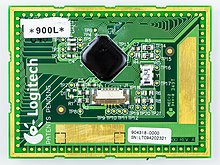The examples and perspective in this articledeal primarily withthe English-speaking worldand do not represent aworldwide viewof the subject.(December 2018) |
"Patent pending"(sometimes abbreviated by" pat. pend. "or" pat. pending ") or"patent applied for"are legal designations or expressions that can be used in relation to a product or process once apatent applicationfor the product or process has been filed, but prior to thepatentbeing issued or the application abandoned. The marking serves to notify the public, business, or potentialinfringerswho would copy theinventionthat they may be liable for damages (includingback-datedroyalties), seizure, andinjunctiononce a patent is issued.


Fraudulentuse of a patent pending designation is prohibited by the law of many countries and inventors should be cautious when marking products or methods that may arguably not be covered by any pending patent application. In some jurisdictions, such as theUnited Kingdom,a warning notice should ideally mention the number of the pending application.[1]
Legislation
editAustralia
editIn Australia, according toIP Australia,the term "patent pending" refers to an invention in respect of which a patent application has been filed at the patent office but for which a patent has not necessarily been granted.[2]The marking of an article has a legal effect under Section 123 of the Patents Act 1990 with the result that a defendant is taken to be aware of the existence of patent rights.[3]
In Australia, the preferred marking is "Aust. Pat. App. No. yyyynnnnnn" where "yyyy" is the four-digit year of the application and "nnnnnn" is the six-digit number allocated by the Australian Patent Office.
There are penalties for making a false indication of the existence of patent rights for any invention.[4]
United States
editIn the United States, according to theUnited States Patent and Trademark Office,the expression "patent pending" as such does not protect an invention until the actual patent is published and/or issued:
A patentee who makes or sells patented articles, or a person who does so for or under the patentee is required to mark the articles with the word "Patent" and the number of the patent. The penalty for failure to mark is that the patentee may not recover damages from an infringer unless the infringer was duly notified of the infringement and continued to infringe after the notice.
The marking of an article as patented when it is not in fact patented is against the law and subjects the offender to a penalty. Some persons mark articles sold with the terms "Patent Applied For" or "Patent Pending". These phrases have no legal effect, but only give information that an application for patent has been filed in the Patent and Trademark Office. The protection afforded by a patent does not start until the actual grant of the patent. False use of these phrases or their equivalent is prohibited.[5]
The use of the term "patent pending" or "patent applied for" is permitted so long as a patent application has actually been filed and is pending, i.e., has not been issued as a patent or become abandoned. If these terms are used for the purpose of deceiving the public when no patent application has been filed, or when the application is not pending, a fine of up to $500 may be imposed for every such offense.[6]Under the Forest Group, Inc. v. Bon Tool Co., 590 F.3d 1295 (Fed. Cir. 2009) decision, the current interpretation of "offense" holds that each mis-marked article constitutes an offense, which permits theoretical damages in the hundreds of millions of dollars for high-volume consumer goods.[7]TheLeahy-Smith America Invents Actrevised section 292 to say that only the United States may sue for that penalty but that a person who has suffered a competitive injury may sue for recovery of damages adequate to compensate for the injury.[8]
Aprovisional application,like any other patent application, also allows the applicant to use the term "patent pending".[9]
In popular culture
editNumerous characters have assumed the name Pat Pending since at least the 1960s, notablyProfessor Pat Pendingof cartoon seriesWacky Races;the name has appeared in at least 21 comics[10]as well as the originalBatmanseries,whereJ. Pat O'Malleyplayed a prolific and rich yet cheap inventor "Pat Pending" in two episodes, likely capitalizing on the marking present on goods throughout the United States.[11][12]
See also
editReferences
edit- ^UK Intellectual Property Officeweb site,Display your rights,(under "IPO Home> Types of IP> Patents> Managing your patents> Using and enforcing" ) Consulted on August 5, 2009.
- ^IP Australia websiteArchived2011-08-29 at theWayback Machine
- ^Patents Act 1990 (Australia, Cth) §123
- ^Patents Act 1990 (Australia, Cth) §178
- ^United States Patent and Trademark Officeweb site,- PATENT MARKING AND "PATENT PENDING"Archived2009-08-02 at theWayback Machine(Excerpted from General Information Concerning Patents print brochure)
- ^35 U.S.C. § 292False Marking.
- ^"Watch Out for Patent Marking Trolls"
- ^Leahy-Smith America Invents Act, § 16
- ^Quinn, Gene (September 14, 2013)."The Benefits of a Provisional Patent Application".ipwatchdog.com.IPWatchdog.RetrievedDecember 22,2013.
Like any other patent application, a provisional patent application is effective to stop the clock relative to so-called statutory bars and immediately upon filing a provisional patent application you can say you have a "patent pending."
- ^"Professor Pat Pending".Comic Vine.GameSpot.Retrieved7 April2018.
- ^"That Darn Catwoman".Batman.19 January 1967.Retrieved7 April2018.
- ^"Scat! Darn Catwoman".Batman.25 January 1967.Retrieved7 April2018.